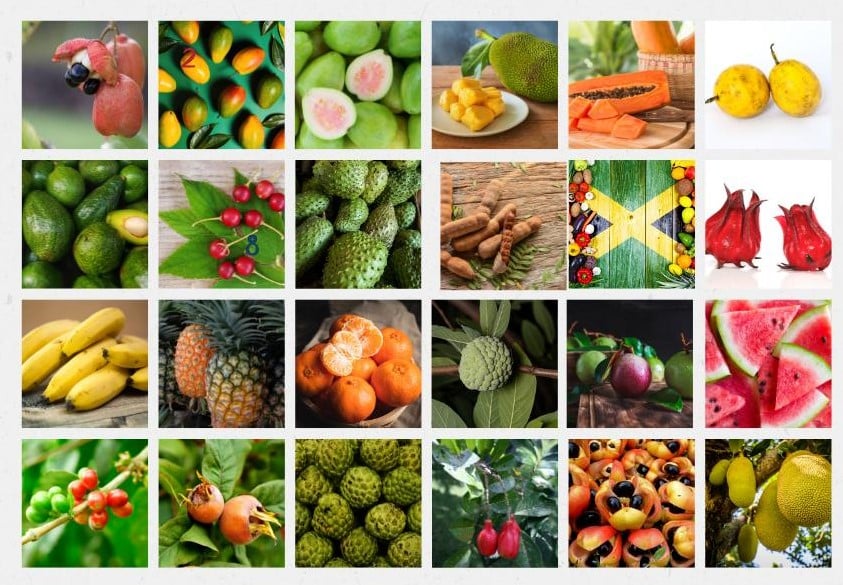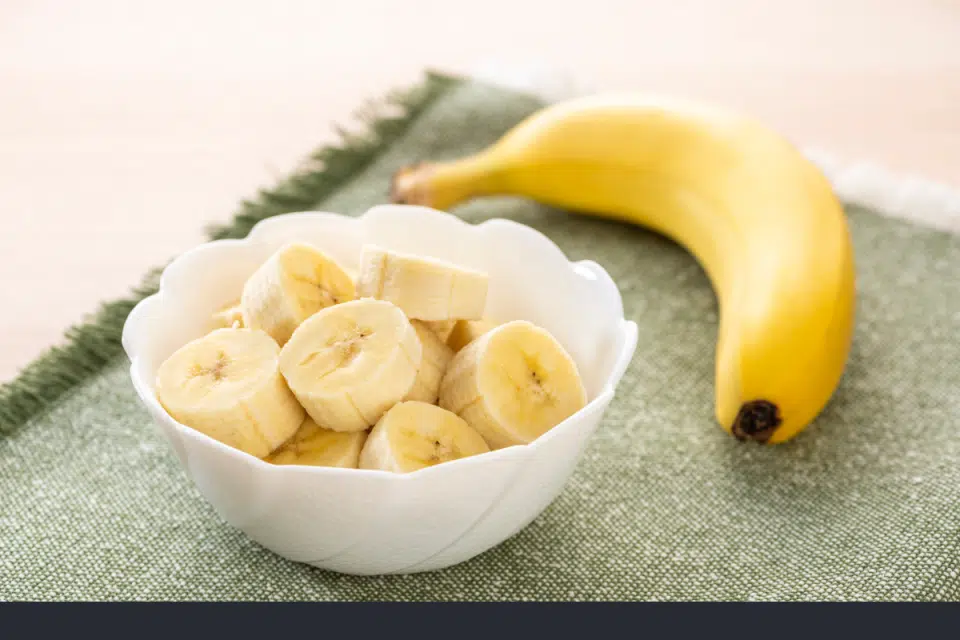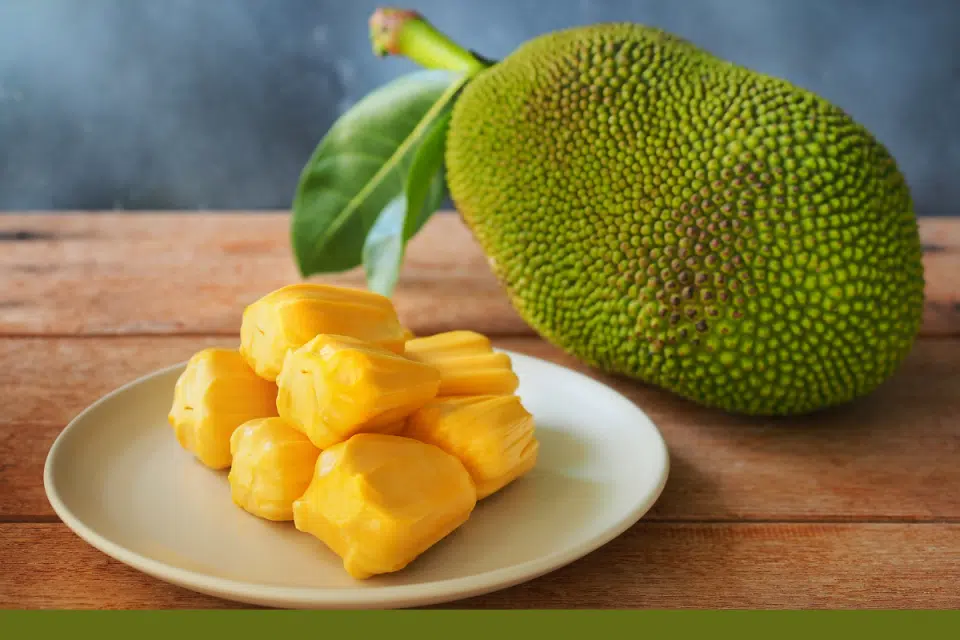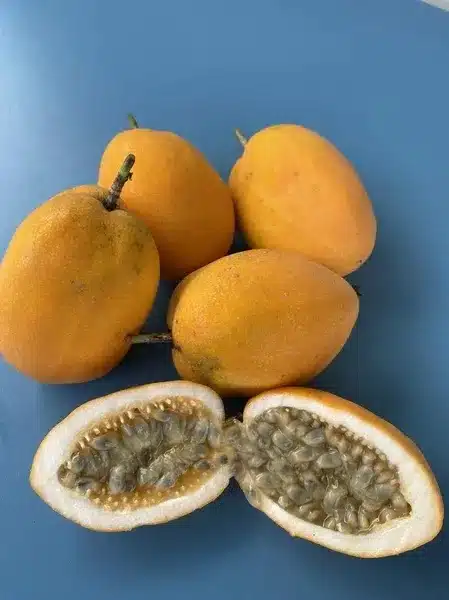Top 22 Jamaican Fruits to Try Out

Jamaica, a tropical Caribbean paradise, is home to an abundance of delicious home grown fruits all year round. Some of these fruits are native to the island and were consumed for centuries by the indigenous Taíno people, while others were introduced by colonist, immigrants and slaves from places like West Africa, India, or as far as Tahiti.
The variety of fruits range from cloyingly sweet to pleasantly sour, richly succulent, and teasingly tangy; and are mainly eaten raw, used in a variety of drinks, or made into jams or jellies. Let’s learn more about locally grown Jamaican fruits.
1. Ackee

The ackee was brought to the island by African slaves and are available all year round.
Ackee is never eaten raw and is a prime ingredient of the country’s national dish: ackee and salt fish. This is a delicious stir fry of the boiled ackee cooked with flaked boiled saltfish and generous amounts of tomatoes, sweet peppers, onions, scallion, garlic, scotch bonnet pepper, seasoned with black pepper and other condiments.
It is usually served as a breakfast dish with fried or boiled dumplings, yam, or boiled green bananas, fried breadfruit, or fried plantains. It is also served for lunch or dinner.
2. Avocado (Jamaican Pear)

In Jamaica, the avocado is called a pear. This fruit is in season from July to December and is available in several varieties.
Pears are very often served with meals as you would vegetables. It is also a popular snack served with bulla cake—a sweet flat cake made with flour, molasses, and baking powder, and often spiced with ginger and nutmeg.
Bulla and pear is a real tasty treat, but some Jamaicans will swear to heaven that pear is a delicious addition to anything, including soups.
3. Banana

Ripe bananas are available all year round, come in different varieties, and are grown all over the island. Ripe bananas are eaten as snacks throughout the day and are a key ingredient in punches, and smoothies.
Banana bread, a moist, sweet cake, is usually baked in a loaf pan, which probably accounts for the name. It is made from mashed ripe bananas, flour, butter, eggs, sugar, coconut, raisins, lime or lemon juice, vanilla extract, cinnamon, nutmeg, and milk.
Overripe bananas never go to waste in most Jamaican homes. They are used for making banana fritters. These tantalizingly tasty titbits are made by combining crushed ripe bananas with flour, brown sugar, eggs, vanilla essence, nutmeg, and baking powder.
Small amounts of this creamy batter are dropped into a frying pan with hot oil and fried to a rich golden-brown color and crisp on the edges. These are enjoyed as a snack or dessert.
4. Cherries

The Jamaican cherry has a vibrant red color and a sweet but tangy taste. It is eaten fresh and made into cherry juice by blending the fruit with water and adding ginger and cane sugar. It is very often combined with the juices from other fruits to make delicious beverages such as pineapple-cherry drink.
5. Custard Apple
The custard apple, which is known in other places as bullock’s heart, has a brown skin when ripe. It is not as common as it used to be, but when found, it is an unforgettable treat.
The creamy custard-like flesh is addictively sweet with an amazingly smooth texture and is usually eaten on its own.
6. Guava

This succulent pear-shaped delight has a distinctively strong aroma and an invitingly tangy flavor. They are available in different varieties from June to September and the color of the flesh ranges from pink to yellow.
Guavas are eaten fresh in Jamaica and also used in combination with other fruits to make delicious beverages such as guava-carrot drink, guava-pineapple drink, and guava-mango drink. The tasty guava jelly or guava jam is an all-time Jamaican favorite that is enjoyed as a snack with crackers or bread.
7. Guinep

Available between June and October, the guinep is a small, green-skinned fruit with a gel-like flesh and a hard seed. It generally has a sweet flavor, but sometimes can be more tangy than sweet. It is best enjoyed when freshly picked.
8. Jackfruit

Finding its way from Southeast Asia to Jamaica, this unusually large fruit is grown all over the island and is available all year round. Packaged in a spiky greenish-yellow skin, the jackfruit is a contradiction in terms; as its strong aroma, which is often a turn-off for many people, is an injustice to the delectable and uniquely breathtaking tastiness of the yellow flesh.
9. June Plum
The June plum, with its green/ yellow skin and inner core with prickly spikes, is eaten green or ripe and the popular June plum juice is quite to die for, as the flesh is blended with ginger, water, and sugar to create a heavenly delight. The flesh is also enjoyed stewed with ginger and cane sugar.
10. Mango

This delicious, juicy fruit has no comparison and is undoubtedly the best-loved fruit on the island. Mangoes came to Jamaica from South Asia in the 1700s and are found in numerous varieties including St. Julian (or Julie), East Indian, Tommy Atkins, Keith, Nelson, common, green skin (or fine skin), number 11, sweetie, and Robin (“raw bin” to most Jamaicans), to name just a few.
The names may vary but the rich, juicy, succulent flavor is unmatched. Every Jamaican swears their favorite is the best! When the fruit is abundant, from March to September, people eat dozens at a time to the extent that there is a Jamaican folk song declaring that during mango season, no cooking is done and nothing but mangoes are eaten.
Mangoes are commonly used in fruit salads, smoothies, and in combination with other fruits to produce divinely flavorful beverages. Mango—the undisputed, undefeated champion of Jamaican fruits.
11. Naseberry

Another Jamaican favorite, the naseberry, is a small, brown, thin-skinned fruit with brownish flesh and big black seeds. Also known as Sapodilla in some Caribbean countries, the naseberry is widely enjoyed for its sweet taste and its unique aroma.
Its enchanting, custard-like flavor is usually enjoyed on its own. Naseberries are grown all over the island and are available from March to July.
12. Ortanique

The ortanique is uniquely Jamaican. It looks like an orange but is a bit flatter, with thicker skin, and is also usually juicier than the orange. A hybrid citrus fruit created from a cross between an orange and a tangerine, it is usually available between November and March. It is eaten fresh or used in juices.
13. Otaheiti Apple

A red skinned, pear-shaped fruit with a spongy white flesh, this Jamaican apple arrived from the island of Tahiti, hence its name. The entire fruit is eaten minus the hard central seed.
It is sometimes used to make a delicious drink, blended with water, ginger, and lime juice and sweetened with cane sugar. The Otaheite apple is available during January to March and May to October.
14. Papaya

Papaya, or pawpaw as it is often called in Jamaica, grows all over the island and is available all year round. Its sweet taste and vibrant orange color make it an absolute must-have in fruit salads and smoothies, though many times it is enjoyed on its own.
15. Jamaican Passionfruit

Available all year round, this green or yellow-skinned fruit grows on a vine. It has an unmistakable tarty flavor and is not usually eaten on its own. When combined with other fruits to create tasty drinks, passion fruit is a perennial crowd-pleaser.
16. Pineapple

The pineapple, with its prickly skin, and yellow, sweet, tangy flesh, is yet another all-time Jamaican favorite. It is available from March to August and is usually enjoyed on its own.
It is also a signature ingredient in fruit salads and often combined with other fruits to create refreshing juices or used to prepare savory meals such as chicken and pineapple.
17. Plums

Jamaica is blessed with a variety of plums. These are tiny fruits with thin skins ranging in color from green to yellow, to red. The varieties have names such as hog plum, may plum, and coolie plum. These are usually available from March to September and are enjoyed as snacks.
18. Soursop

The soursop, also called Graviola in other places, comes in a green, leather-like skin covered with soft, curved spines with white fleshy pulp inside. Some say the taste is a marvelous mixture of pineapple and banana. It is not very popularly eaten fresh.
However, its popularity as a drink (made with sweetened condensed milk to give a rich creamy taste or adding lime juice and sweetening with cane sugar) is inarguably unrivaled. It is also used in the making of desserts such as soursop ice cream. It is in abundance from July to October.
19. Starapple

This thick, shiny, green, or purple-skinned fruit has a milky, sweet, juicy flesh with a delightful taste but unmistakably tarty texture. It is a round fruit and when cut across a unique star-like pattern is revealed, hence its name. A delicious snack, it is enjoyed especially during January to March.
20. Sweetsop

The sweetsop is called sugar apple in some countries and, as its name suggests, it is a fruit whose sweetness is incomparable. It is usually in abundance during the summer but is grown all year round. It has a creamy, delectable flavor and is enjoyed fresh on its own.
21. Tamarind

Believed to have come to Jamaica in the 19th century with the arrival of the Indian indentured laborers, the tamarind has a brown, pod-like exterior and sticky pulp inside with a strange but enticing mixture of a very sweet and very sour taste which cannot be confused with anything else.
Tamarinds are available from February to April and are used to make a delightful tangy candy known as tamarind balls in which the flesh along with the seed is mixed with cane sugar and rolled into little balls of joy enjoyed by Jamaicans of all ages. Tamarinds are also used to make a refreshing beverage and to add a zesty flavor to sauces.
22. Watermelon

Another great favorite among Jamaicans of all ages, the watermelon, with its succulent, and very juicy, red flesh, is enjoyed all year round but is in abundance during the period March to September. The fruit is enjoyed fresh and works wonderfully well as a prime ingredient in fruit salads and smoothies, as well as the liquid base in thirst-quenching drinks.
Related: Top 25 Jamaican Foods
Related: Most Popular Jamaican Drinks
Related: Most Popular Jamaican Desserts

